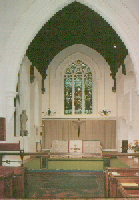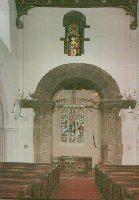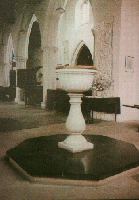Services - all welcome
|
St Ben't's Church stands out from the other surviving Cambridge churches for five reasons:
- early foundation (c1020)
- Anglo-Saxon tower (c1025)
- foundation of Corpus Christi College (1352)
- foundation of the art of change ringing (c1650s)
- connection with the Society of St Francis (1945)
Early Foundation
There are over 260 churches in England and Wales in which Anglo-Saxon works survives with the earliest dating from the seventh century. St Ben't's is a mere strippling erected some 350 years later in the beginning of the second quarter of the eleventh century in the reign of Canute. Very few Anglo-Saxon churches carry the name St Bene't who was a saint for monks and monasteries and it can only be surmised that the founder or founders had some monkish association that inspired the dedication.Anglo-Saxon Tower
The tower is the oldest building in Cambridge and indeed in the county. It is notable for the "long and short quoins (corner stones)" which is typical of Anglo-Saxon buildings. The arch is a special feature.Corpus Christi College
While other churches in Cambridge have links with colleges, for instance Little St Mary's with Peterhouse and St Edward's with Trinity Hall, that of St Bene't's goes back to the College's foundation.In the fourteenth century, the church was used by some of the Cambridge Guilds (associations of men and women then popular with merchants and craftsmen). The Guild of Corpus Christi met at St Bene't's and joined with that of St Mary, linked with Great St Mary's Church, to found the College of Corpus Christi in 1352. St Bene't's was used as the college chapel for many years and the two still have strong links.
Change Ringing
Fabian Stedman who introduced change-ringing was parish clerk to St Bene't's in 1670 and is believed to have taught his system to the church ringers. There is a plaque to his memory in the tower. The bells are still rung each week.
Society of St Francis
Since 1945 the vicar has been appointed from the Order of the Society of St Francis and the Brothers live near the church in accommodation owned by Corpus Christi College.
Plan of church
 |
 |
 |
| Altar | Saxon Arch | Font |
Short history
The church of St Benedict, generally shortened to St Bene't, has been a place of prayer and worship for over 900 years. Not only the famous tower but also the naive and, it is believed, part of the chancel were built in Saxon Times. The exact date is in dispute; estimates vary between the 10th century and the reign of Edward the Confessor, but there are good grounds for placing it in the reign of King Canute, about the year 1020. It is the oldest building in the county of Cambridgeshire. In spite of its name, St Bene't's was never monastic and has been a parish church from the beginning, but services were held in by Corpus Christi College between 1353 and 1579, and for a time to was their only chapel.The north and east walls of the chancel were rebuilt in their original positions in the 19th century, but the south wall, which may be part of the original Saxon church, was allowed to remain. Work of several periods may be seen in it:- two widely-splayed blocked windows, probably of the 13th century, the sedilia and double piscina, much mutilated, of the 14th century and a blocked segmental-headed opening of the late 15th century, which gave a view of the high alter from the adjacent building. The bases of the Saxon chancel arch remain beneath the floor, and those of its successor, of the 14th century can still be seen. The existing arch is modern.
South of the chancel is an interesting brick range, put up between 1487 and 1515, which consisted originally of upper and lower chapels adjoining the church, connected with Corpus Christi College, but the lower chapel is leased to the church as a vestry.
The nave has suffered much alteration, but the lower part of all four Saxon quoins, of long and short work, remains. It is probable that the original height of the roof ridge was much the same as at present, and that there were at first no aisles. The walls were pierced or rebuilt, to form the existing arcades leading to the aisles, lat4 in the 13th century. The clerestory, which has been much altered and renewed, dates from the 15th century, when a new roof, of lower pitch than the original one, was ordered in 1452. All the existing roofs in the church are modern.
The aisles were rebuilt and enlarged and the organ chamber added in the 19th century. The wall of the spiral staircase of the adjacent college building can be seen in the south-east corner of the south aisle. The alter in the same aisle is part of a medieval stone slab, probably of early date. On the floor is a brass to Richard Billingford, DD, Master of Corpus Christi and Chancellor of the University, who died in 1432. He wears a doctor's cap, and the robe called a cappa clausa, which is still in use for certain University ceremonies. The north aisle contains a 17th century bier and a fire hook for removing the thatch of houses which had caught fire. The chest may have belonged to the Guild of St Catherine which was founded in this Church in 1389.
The tower is a good example of its date. The long-and-short works of the quoins, the double belfry windows with moulded balustrade shafts separating the lights, and the great arch leading in the church, are all characteristics of late Saxon work, though the two beasts on the imposts of the arch are not paralleled elsewhere. The large single-light belfry windows are insertions of the year 1586. There are six bells, dated 1663, 1588, 1607, 1825, 1610 and 1618. Fabian Stedman who introduced change-ringing, was parish clerk here in 1670 and is believed to have taught the system to the ringers in the tower.
Since 1578 there have been 73 incumbents at St Bene't's and 52 of these have been members of the Corpus Christi. Most did not stay long owing to the lack of a Rectory as they had to move elsewhere when they were married. Many had distinguished careers, for eight became Masters of the College, four Bishops and two Archbishops. In 1939 Michael Ramsey, the future Archbishop of Canterbury, left to take up an appointment in Durham and during the first years of the war T O Cobham, Principal of Queen's College, Birmingham acted as Vicar when he and his students moved to Cambridge.
At this point a new link was forged with the Franciscan Friars, who were helping at St Edward's and the Church of the Good Shepherd. Brother Denis Marsh of the Society of St Francis had been preaching in Holy Week and giving addresses to the students and the College and the Bishp invited him to become Priest-in-Charge during the absence of the Vicar who went to work as Chaplain to the Forces. He was very happy that someone "competent and delightful as Father Denis" would be in charge while he was away.
In 1945 the Vicar resigned when his own College reopened and Father Denis continued with the help of Father Lothian who succeeded to the living in 1948. The College expressed hope that this would be a lasting appointment but in 1966 the Society of St Francis gave up their house in Lady Margaret Road, which had been a centre of activity for members of the University, and Father Lothian resigned. The Bishop was much upset by this change of plan, since he set great value on the work of the Brothers in Cambridge, and it was finally agreed that they would stay in a house provided by the College in Botolph Lane.
The Reservation of the Sacrament in the Church began at this time, since the Brothers no longer had their chapel in Lady Margaret Road. After Father Lothian's death in 1970, Brother Martin became Vicar until 1985. At that time the Diocese was reducing the number of livings in the town centre and Brother Thomas Anthony was licensed as Priest-in Charge while presentation to the living was suspended. Happily he was inducted as Vicar in 1988 and the College welcomed the decision that the Friars were to remain in Cambridge and helped to provide additional accommodation in Botolph Lane.
St Bene't's then is a church with some unusual features which helps to account for its special atmosphere and individuality. The link with the College may have brought problems from time to time but has been fruitful through the centuries while that of the Friars which would surely have astonished those first arrivals in the thirteenth century is something for which we are all thankful and pray may long continue.
These notes are drawn from a number of sources and there is an excellent guide for sale in the Church.